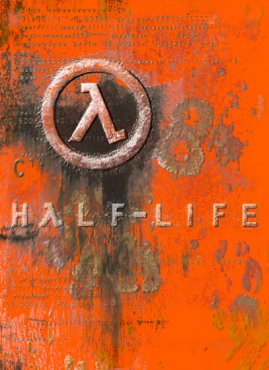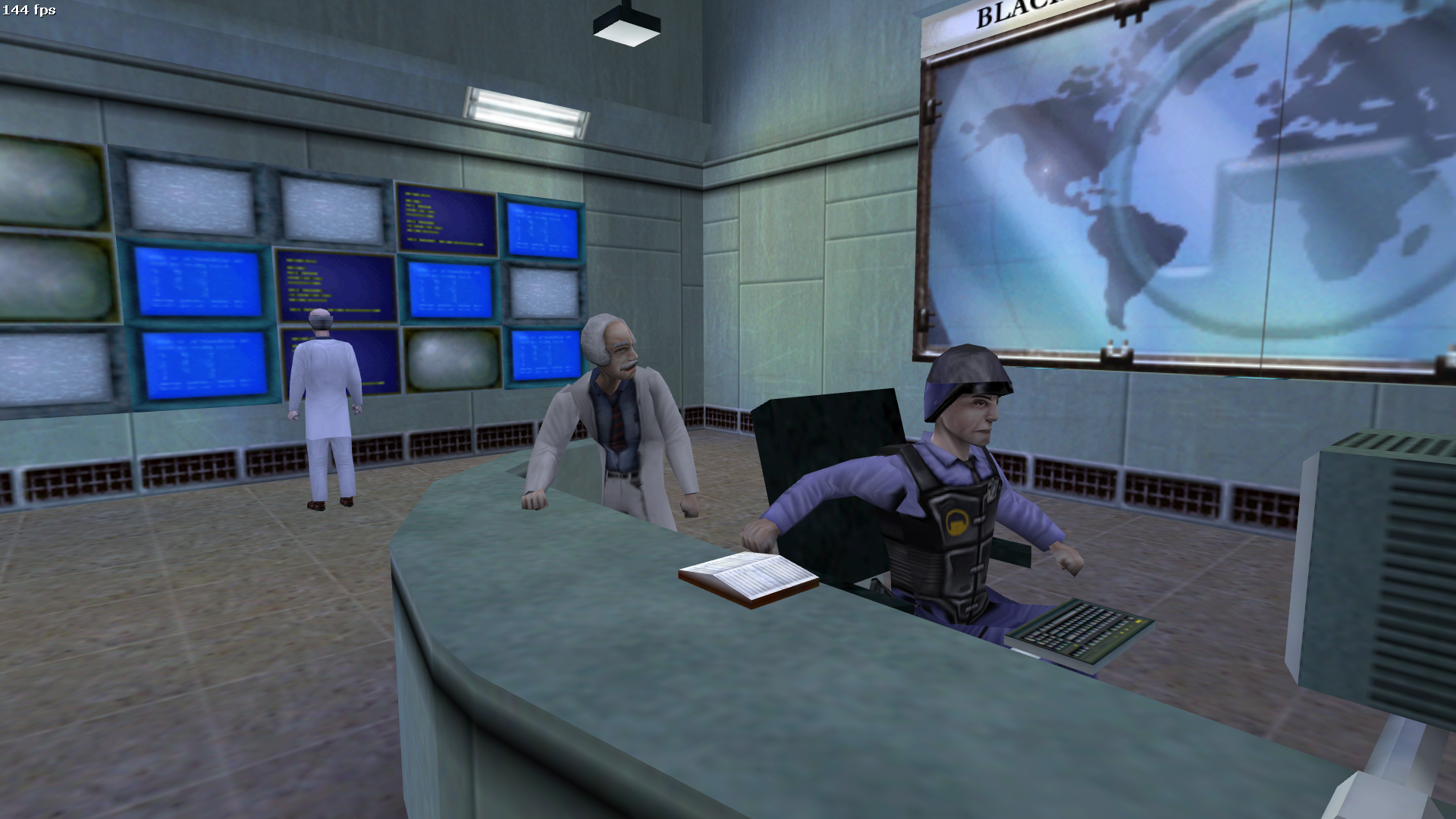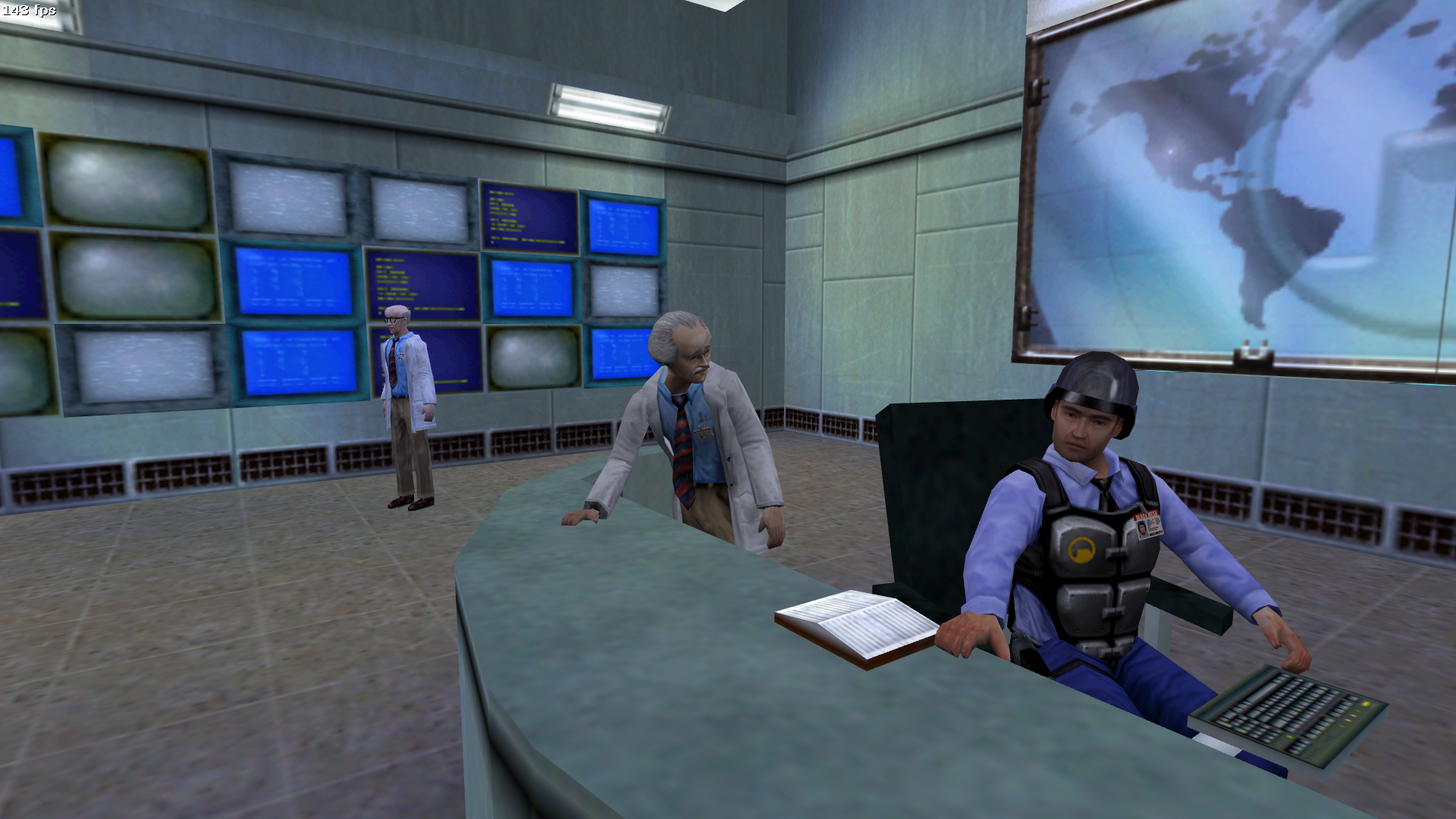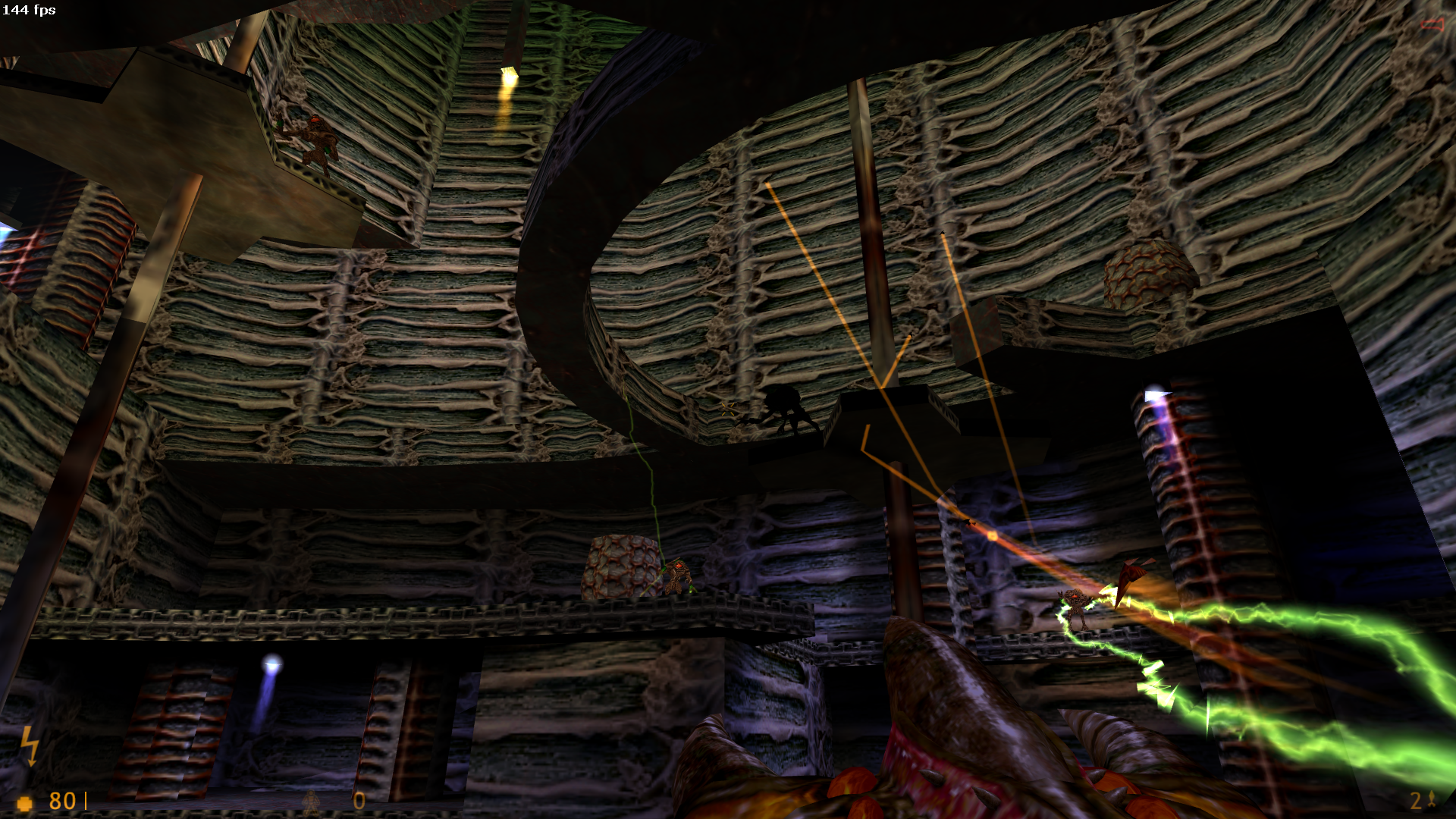Blast from the Past: Half-Life
Blast from the Past
Half-Life

This episode goes over the legendary Half-Life! The game that spawned a massive modding community, made us fall in love with crowbars and silent protagonists, and is likely the introduction for a whole generation of people to first person shooters.
Graphics⌗
I’m going to get this out of the way first. This is a late 90’s era game. Polygonal models were starting to get more details, but polygon counts and texture resolution was at a premium. Models got some updates over the years, but by today’s standards, are pretty lacking in detail (even the HD models). You’ll see a lot of low resolution models and blurry textures. I still think the game is still visually pleasing, even today. The art direction ties in nicely with the technology they had at the time, and nothing feels out of place.


Story⌗
I’m actually not going to go over the synopsis of the game. You can go to Wikipedia for that. However, I’m going to go over what the experience of the story is like. The only things you need to know is that you are a scientist named Gordon Freeman who works for the Black Mesa Research Facility, and one day, things go terribly wrong!
Half-Life is a bit of a different beast compared to other shooters when it comes to how it delivers its story. Especially if you’ve grown up playing modern shooters. There are no traditional cutscenes in Half-Life. No pre-rendered videos and no in-engine, pre-animated cinematics. Instead, Half-Life, and it’s sequel Half-Life 2, opt to never take away player control. You can move around and look at whatever you want during pre-scripted “cinematic” sequences. While the game doesn’t force you to watch anything, it does gate you from progressing forward until the sequence finishes playing out.
This means that you, as the player, never get taken out of Gordon’s head. You see everything as he sees it, and experience everything as he experiences it. This creates an incredibly diegetic storytelling experience. As a player, you can blow by everything and barely absorb any of the story. After all, you don’t have to sit and wait for this NPC to finish his lines to move on 95% of the time. You can keep on hopping along. However, the folks at 90’s Valve hid a lot of world building tidbits in the game. Some of which are referenced in future entries in the series!
It’s not a complicated story, but there’s lots of little things to discover that fleshes out the world. The game puts the player and their imagination in charge and doesn’t hold your hand. For the technology of the era, Valve did a fantastic job of telling the story they wanted to tell and making a game that still stands up today.
Gameplay⌗
Movement⌗
As mentioned earlier, this is a late 90’s era game. id Software was still the king of the first person shooter. Quake and other similar style games were hot commodities. Almost every shooter that came out in this era was 99% likely to be using, or heavily based on, the Quake engine. Half-Life is no exception. Walking diagonally is still preferred and you jump everywhere, because life is slightly faster when you’re airborne and wiggling your head around. Coming to a stop feels like you’re on ice when precision movements are required. But it feels good. It makes no sense, but the feeling of moving around in these Quake style games feels exhilarating, yet controlled.
You’re flying through the air like a jackelope in the wind, you see a jumping “puzzle” ahead. “I’m going to hop through this at top speed like a badass.” you think to yourself. You brazenly jump past the first platform. You’re going fast enough, you can skip the first stop. Clunk, you lad on the second platform. All according to plan. You press spacebar and jump again. Trajectory looks good, we’re gonna make it! As you approach your destination, you spy a little piece of broken handrail that stick out farther than the rest. You try to evade, but your path is set. You barely nick the handrail and fall to your doom.
You reload your last save … it was from 10 minutes ago. Fast forward, you’re back to the jumping “puzzle”. You save your game this time, not gonna lose another 10 minutes. You attempt your hopping at full speed again. Still clip the handrail. “Just need to warm back up again. Replaying that last 10 minutes made me lose my muscle memory.” you tell yourself. A third attempt is made, you make it to the second platform, but you hit the spacebar just a little too late, you’ve slid past the ledge and fall to your death. You try a few more times. Ultimately, you give in, defeated, and complete the “puzzle” the way the developers intended you to.
Years later, you replay the game, an older, wiser gamer. You practice your strafe jumping and your bunny hops to get back into the feel of it. You get to the jumping “puzzle” and attempt the skip you tried all those years before. You jump and land on the second platform, easy peasy. Perfect spacebar timing, you hop again. Ah-ha! I remember you handrail piece! Not today! Your dodge the handrail this time and land successfully on the other side. “Man”, you think to yourself, “That wasn’t nearly as hard as I remember it being.”
I think every gamer who played first person shooters back in this time period and earlier has lived this experience. Games don’t give you that anymore. Not to say all of the fancy modern movement mechanics aren’t great, but there’s something lacking. Just moving around isn’t as fun anymore as it used to be. Now, let’s call out some of the downsides of these older games. As mentioned in our little story, you hit small pieces of geometry ALL … THE … TIME! You could be going a million miles an hour one second, snag a pin and now you’re at a dead stop. Since polygon counts were still low, physics geometry could almost match the model geometry 1-to-1. That meant every little detail had collision. Most of the time you didn’t even see what you ran into, but you knew you hit something. Modern movement mechanics like clamber and ledge forgiveness didn’t exist yet. Some later games in the 2000’s started experimenting with it, but it took a little while longer before it became mainstream. This meant that the feet of your character had to be above whatever you were trying to land on, and no ledge forgiveness meant that if you hit that jump button just a little too late, you didn’t jump.
These old games could be brutally unforgiving, but it was very satisfying when you mastered them. All the movement oddities formed some niche communities. Like surfing in Counter-Strike, a side effect of how the Half-Life engine resolved it’s movement. Grenade jumping, an unintentional side effect introduced in Quake, was kept as well. Oh yeah, and let’s not forget moving diagonally was faster than moving in a cardinal direction! While I don’t think this is true in Half-Life’s case, it was for many games in the 90’s. This is mainly a performance optimization, because it was cheaper to not calculate the square root of the combined input to get a uniform speed across all movement directions. I know this stuck with me and I still moved diagonally while playing Half-Life, even though it most likely didn’t help me go faster.
Who knew a writeup on movement could be so long? I have a lot of nostalgia for the movement mechanics of these old games. There’s a deep rabbit hole of little tricks and gotchas that can make them really fun, and, if I’m being honest, I really miss it. But if that’s not your cup of tea, you can keep your feet planted to the ground and still have a good time.
Gunplay⌗
Half-Life’s gunplay, in the range of die in a couple hits to bullet sponge, lives somewhere in the middle. You’re vulnerable enough that you don’t want to jump out into the open, guns blazing, but if you need to tank some shots, you can do that in some capacity. Enemies are similar. The common enemies have a little sponginess to them, but not so much that a fight drags on too long. If you know what weapons to use at what distance, you can take enemies out fairly quickly. Similarly with the common Xen enemies. The not so common enemies have their quirks. Either a specific kind of weapon needs to be used (e.g. explosives), or there’s a “puzzle” in the level that defeats the enemy for you. There are a handful of enemies that are straight up bullet sponges, but the game never reaches the point where it’s flooding them on you. All in all, the game feels appropriate the entire time.
Half-Life’s enemies are split between human and alien. The human enemies are nothing special, standard military themed enemies. The alien enemies are all unique in how they attack and how they look. It is impossible to mistake one alien enemy for another.
Half-Life has a few guns. Okay, more than a few. Fourteen to be exact. It has a mixture of standard fair first person shooter weapons and few unique weapons. I won’t go over all of them, but I’ll highlight the unique weapons.
From the human side, we have the Tau Cannon, that essentially shoots electricity. From a gunplay perspective, it’s not too interesting. It has a regular fire and a charge shot. Where things get interesting is the charge shot will knock you backwards depending on how much charge you’ve built. If you fully charge it, you can launch yourself and do some pretty neat jumps.

There are 2 alien weapons we get to wield. One has regenerating ammo, and it’s primary fire shoots homing bullets that can track enemies around corners. The other is a “grenade” of little alien creatures that mercilessly follow enemies and bite them until they die.
And of course, no discussion about Half-Life weaponry is complete without mentioning the crowbar. It is the only melee weapon in the game, and it is your trusty ally and friend through the whole game. It’s main uses are to beat headcrabs and break things in the environment, mainly air duct openings and boxes. Gordon clearly doesn’t skip arm day, because when he’s hitting something, he flails that crowbar inhumanly fast.
Even with all this weapon variety, I found myself, in a casual playthrough on Medium difficulty, using two weapons primarily throughout the game. Maybe on Hard difficulty the other weapons shine a bit more, but I found the assault rifle and the shotgun handled the majority of my needs. At least until I ran low on ammo towards the end of the game.
Audio⌗
The audio design in Half-Life is quite spectacular, because it’s so subtle. None of the sound effects feel out of place. Everything feels cohesive, like it belongs in this world. Some of the weapon sounds are a tad unrealistic (looking at you pistol), but it’s something you can easily look past.
One thing players may note is that the there’s almost no music in the game. If you stand still with no enemies around, the game is eerily silent, save for maybe a few ambient noises. No music accompanies the silence. It’s eerie, but it feels right. When the music does come on, it’s bangin’. The music doesn’t give off badassery vibes, but it gives you the sense that you’re doing something incredibly cool.
Summary⌗
This has been a longer than usual writeup, but I just replayed Half-Life, and I had lots of feelings to share.
Whether you love it or hate it, whether it’s your favorite first person shooter or not, Half-Life is undeniably a classic that stands the test time. It will visually become more dated, but it remains a cohesive experience that reminds us that even with the limitations of old technology, it is still possible to provide a memorable player experience.